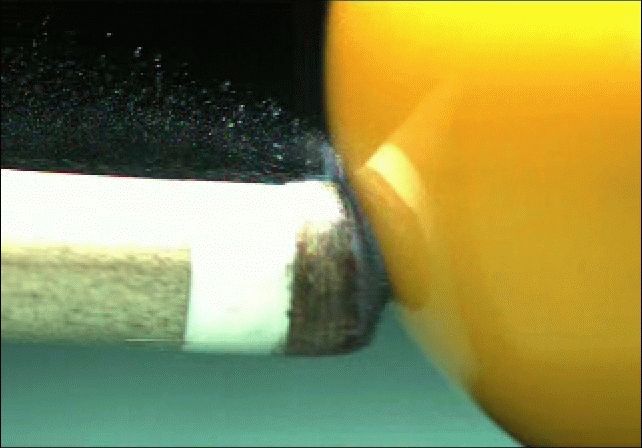Professionals replace their pool cue tips every six months on average, depending on the amount of time they spend practicing for tournaments. In contrast, most amateur pool players leave their cue tip on until it fails. Either the cue tip breaks off or it starts to come apart.
Amateurs' cue tips are usually not radiused with a tip tool and are generally mushroomed and glazed over. Pool cue tips need to be radiused and scuffed on a regular basis in order for the pool cue to play consistently and to peak performance. The radius tool puts the proper curvature on the cue tip and scuffing increases the tip's ability to hold chalk, which in turn puts more grip on the cue ball. More grip on the cue ball means less chance of a miscue.
Low quality cue tips such as Le Pro can last a long time as long as they don't come apart or delaminate. The problem with low quality cue tips is that hardness varies in the same production batch - the tip might be hard, soft, or medium coming out of the same box. Cheap cue tips mushroom faster and glaze more easily, causing more miscues. Cheap tips just don't play as well as high quality tips.
 This photo shows a pool cue tip in good condition absorbing the shock of the hit on a cue ball. A worn cue tip will absorb less shock, compressing less, therefore producing less spin and cue ball action. You would expect to notice more miscues and less cue ball action, but cue tips wear so gradually that you may not notice any difference in hit quality or feel.
This photo shows a pool cue tip in good condition absorbing the shock of the hit on a cue ball. A worn cue tip will absorb less shock, compressing less, therefore producing less spin and cue ball action. You would expect to notice more miscues and less cue ball action, but cue tips wear so gradually that you may not notice any difference in hit quality or feel.
Deformation of the cue tip's radius does not dictate replacement as deformation occurs with normal use. Re-radiusing with a good tip tool such as the ULTI-MATE Tip Tool will restore the optimum shape. According to Dr Dave at the University of Colorado, "If your tip is properly shaped and you are hitting the cueball within the non-miscue zone, the extreme edge of the tip doesn't come into play." Mushrooming is also not cause for cue tip replacement.
The criteria for cue tip repair is thickness of the outer edge of the cue tip, measured from the top of the ferrule to where the cue tip begins to curve (not including the dome or radius). Tony at Tiger Products recommends replacing Tiger's cue tips once the outer edge reaches 1/16". We replace Tiger's tips just before they reach that point. John Bertone at Kamui Tips recommends cue tip replacement for the Kamui Clear Black at 1/8" and 3/16" for the Kamui Black.
 If the cue tip is worn down too low, the shaft's ferrule will mushroom and crack. Ferrule damage results from lack of tip material to absorb shock. Ironically, you experience more feel while you're ruining the ferrule. Many pool players come to us for cue tip repair and end up needing a new ferrule as well, costing about $65. They tried to get their "money's worth" from the cue tip and wore it down until nothing is left, or they used their billiard cue as a break cue. Either way, the same result, a fractured or cracked ferrule. Most production cues, particularly cues and shafts made in China, use very low grade plastic ferrules that fracture easily. On the other hand, Tad, Schon, Tiger, Jacoby, and other custom cue makers use very high quality materials that will withstand greater amounts of abuse.
If the cue tip is worn down too low, the shaft's ferrule will mushroom and crack. Ferrule damage results from lack of tip material to absorb shock. Ironically, you experience more feel while you're ruining the ferrule. Many pool players come to us for cue tip repair and end up needing a new ferrule as well, costing about $65. They tried to get their "money's worth" from the cue tip and wore it down until nothing is left, or they used their billiard cue as a break cue. Either way, the same result, a fractured or cracked ferrule. Most production cues, particularly cues and shafts made in China, use very low grade plastic ferrules that fracture easily. On the other hand, Tad, Schon, Tiger, Jacoby, and other custom cue makers use very high quality materials that will withstand greater amounts of abuse.
Pool players are repairing their cue tips much too late and it's costing them more money when their ferrules crack. If your cue tip edge is down to 1/8" or less, replace it now to save your ferrule, and if you're not using a break cue, consider getting one with an extra tough phenolic tip.

